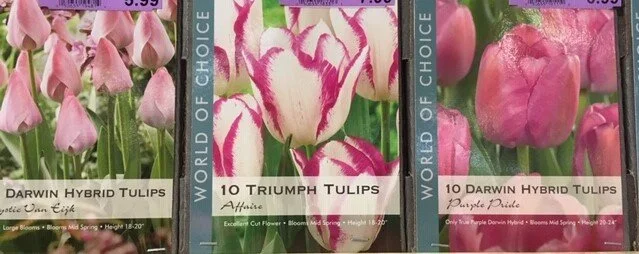Caring for Bulbs
Bulbs are among the easiest group of plants to grow and care for. There is a vast variety of bulbs and they require very little effort.
Since bulbs store everything they need to grow and develop foliage and blooms, very little attention is required from the gardener. Hardy bulbs remain underground, enduring freezing temperatures, drought and extreme heat. There are a few tips to remember about caring for your bulbs.
Plant properly as quickly as possible after you get them home, see previous instructions. If you must store them for a short period, keep them in the refrigerator so they remain dormant. Water thoroughly just after planting.
If you have planted your bulbs in a container they will need frequent watering once the sprouts emerge from the soil. After blooming make sure they receive water about once a month.
Keep the soil moist but not soggy, most bulbs prefer a relatively dry soil through summer and fall so don’t over do it. Don’t neglect watering in hot dry periods and dry autumns. Deep watering less frequently is best - don’t forget those bulbs are often 6 - 8” deep and you want to get water to the roots.
If your soil is poor, fertilize after blooming with a balanced fertilizer to aid next year’s bloom. Bulbs will begin storing nutrients just after the bloom period, so be sure they get what they need for next season. Use a bulb food fertilizer rather than bone meal, which has little value and attracts dogs looking for bones! A low nitrogen 5-10-5, up to 12-12-12 fertilizer is best as high nitrogen will encourage foliage growth rather than blooms. Apply granular fertilizer at a rate of about 2 pounds per 100 square feet.
Summer or fall blooming bulbs can be fertilized monthly after the shoots have emerged. Discontinue fertilizing when the plant is in bloom.
Cut off flower stems only after blooming to prevent seed formation. Developing seeds uses energy from the bulb at the time it needs to be storing for next season.
Daffodil blooms do not need to be removed after blooming. And allow the foliage to yellow and wither naturally in the sun to store energy for next years blooms, do not tie up or braid the foliage.
Allow the foliage to die back before removing. The foliage is collecting energy (photosynthesis) to store in the bulb for next season. So again, don’t tie up or braid the foliage.
After the ground freezes, cover with 2 to 4” of mulch to keep soil temperatures more constant.
Move mulch away from the plants when they emerge in spring.
Tall summer blooming bulbs such as dahlias may require a support ring or stake to keep them upright in windy conditions or heavy rain. Stakes should be installed when planting to avoid damage to the bulb.
Hardy bulbs can be dug up at their recommended planting time to be moved or divided. You will know if it is time to divide if the plants have become too crowded or are not blooming well.
If your bulbs fail to grow or bloom in spring, there are a number of possible reasons. Dig one or two up to see if they rotted, in which case your site does not have proper drainage. The site may not receive enough sun, most bulbs need at least 4 to 6 hours. If your bulbs grew and bloomed last year, did you remove foliage too soon? If so, not enough energy was stored to produce a blooms. They may bloom next year, but perhaps not. Lastly, unless you purchased your bulbs from a reputable dealer, perhaps the bulbs were not stored properly and were dead when you purchased them.
As your bulbs multiply and begin to crowd each other, they may be dug up and divided to keep them healthy. This may be done in fall, but the best time to identify their location is just after the foliage has withered, Dig them up with a fork or spade, taking care not to cut or damage them. Then immediately replant at the same depth and spread apart three times their diameter.
